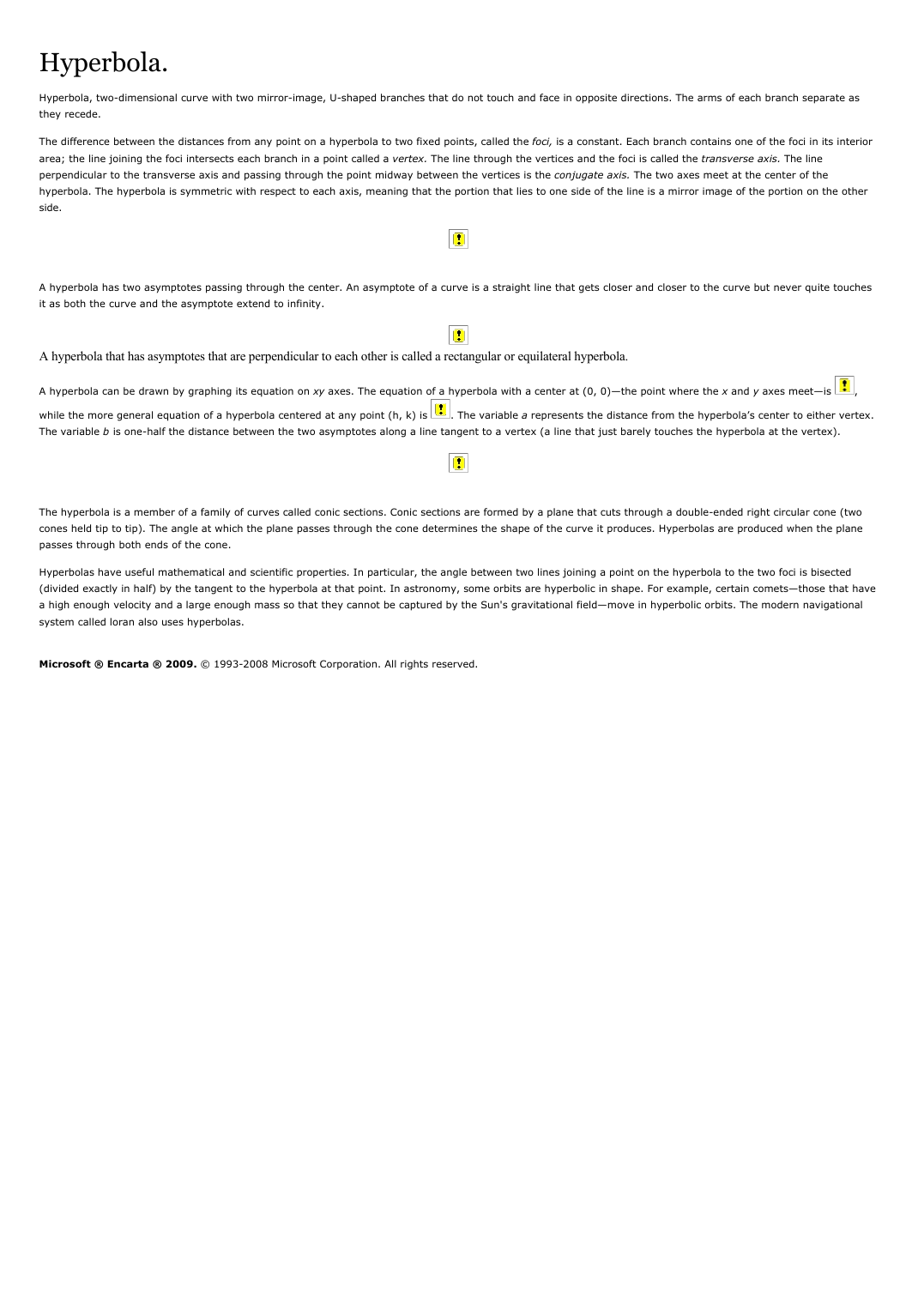Hyperbola.
Publié le 06/12/2021

Extrait du document
Ci-dessous un extrait traitant le sujet : Hyperbola.. Ce document contient 458 mots. Pour le télécharger en entier, envoyez-nous un de vos documents grâce à notre système d’échange gratuit de ressources numériques ou achetez-le pour la modique somme d’un euro symbolique. Cette aide totalement rédigée en format pdf sera utile aux lycéens ou étudiants ayant un devoir à réaliser ou une leçon à approfondir en : Echange
Hyperbola.
Hyperbola, two-dimensional curve with two mirror-image, U-shaped branches that do not touch and face in opposite directions. The arms of each branch separate as
they recede.
The difference between the distances from any point on a hyperbola to two fixed points, called the foci, is a constant. Each branch contains one of the foci in its interior
area; the line joining the foci intersects each branch in a point called a vertex. The line through the vertices and the foci is called the transverse axis. The line
perpendicular to the transverse axis and passing through the point midway between the vertices is the conjugate axis. The two axes meet at the center of the
hyperbola. The hyperbola is symmetric with respect to each axis, meaning that the portion that lies to one side of the line is a mirror image of the portion on the other
side.
A hyperbola has two asymptotes passing through the center. An asymptote of a curve is a straight line that gets closer and closer to the curve but never quite touches
it as both the curve and the asymptote extend to infinity.
A hyperbola that has asymptotes that are perpendicular to each other is called a rectangular or equilateral hyperbola.
A hyperbola can be drawn by graphing its equation on xy axes. The equation of a hyperbola with a center at (0, 0)--the point where the x and y axes meet--is
while the more general equation of a hyperbola centered at any point (h, k) is
,
. The variable a represents the distance from the hyperbola's center to either vertex.
The variable b is one-half the distance between the two asymptotes along a line tangent to a vertex (a line that just barely touches the hyperbola at the vertex).
The hyperbola is a member of a family of curves called conic sections. Conic sections are formed by a plane that cuts through a double-ended right circular cone (two
cones held tip to tip). The angle at which the plane passes through the cone determines the shape of the curve it produces. Hyperbolas are produced when the plane
passes through both ends of the cone.
Hyperbolas have useful mathematical and scientific properties. In particular, the angle between two lines joining a point on the hyperbola to the two foci is bisected
(divided exactly in half) by the tangent to the hyperbola at that point. In astronomy, some orbits are hyperbolic in shape. For example, certain comets--those that have
a high enough velocity and a large enough mass so that they cannot be captured by the Sun's gravitational field--move in hyperbolic orbits. The modern navigational
system called loran also uses hyperbolas.
Microsoft ® Encarta ® 2009. © 1993-2008 Microsoft Corporation. All rights reserved.
Hyperbola.
Hyperbola, two-dimensional curve with two mirror-image, U-shaped branches that do not touch and face in opposite directions. The arms of each branch separate as
they recede.
The difference between the distances from any point on a hyperbola to two fixed points, called the foci, is a constant. Each branch contains one of the foci in its interior
area; the line joining the foci intersects each branch in a point called a vertex. The line through the vertices and the foci is called the transverse axis. The line
perpendicular to the transverse axis and passing through the point midway between the vertices is the conjugate axis. The two axes meet at the center of the
hyperbola. The hyperbola is symmetric with respect to each axis, meaning that the portion that lies to one side of the line is a mirror image of the portion on the other
side.
A hyperbola has two asymptotes passing through the center. An asymptote of a curve is a straight line that gets closer and closer to the curve but never quite touches
it as both the curve and the asymptote extend to infinity.
A hyperbola that has asymptotes that are perpendicular to each other is called a rectangular or equilateral hyperbola.
A hyperbola can be drawn by graphing its equation on xy axes. The equation of a hyperbola with a center at (0, 0)--the point where the x and y axes meet--is
while the more general equation of a hyperbola centered at any point (h, k) is
,
. The variable a represents the distance from the hyperbola's center to either vertex.
The variable b is one-half the distance between the two asymptotes along a line tangent to a vertex (a line that just barely touches the hyperbola at the vertex).
The hyperbola is a member of a family of curves called conic sections. Conic sections are formed by a plane that cuts through a double-ended right circular cone (two
cones held tip to tip). The angle at which the plane passes through the cone determines the shape of the curve it produces. Hyperbolas are produced when the plane
passes through both ends of the cone.
Hyperbolas have useful mathematical and scientific properties. In particular, the angle between two lines joining a point on the hyperbola to the two foci is bisected
(divided exactly in half) by the tangent to the hyperbola at that point. In astronomy, some orbits are hyperbolic in shape. For example, certain comets--those that have
a high enough velocity and a large enough mass so that they cannot be captured by the Sun's gravitational field--move in hyperbolic orbits. The modern navigational
system called loran also uses hyperbolas.
Microsoft ® Encarta ® 2009. © 1993-2008 Microsoft Corporation. All rights reserved.
↓↓↓ APERÇU DU DOCUMENT ↓↓↓


